FC Martigues were relegated from France’s top flight 27 seasons ago after they finished bottom of the table. It would be the last time, as of this moment, that they played among France’s elite.
Things went from bad to catastrophic for the club based not far from Marseille in 2003, as financial problems forced them into liquidation — a crushing blow that ensured any aspirations of a return to the top tier would be long-term goals.
Martigues would reform and rebuild, reaching the heights of the third tier once more but this is as far as they’ve managed to climb back up the pyramid since their liquidation.
In 2012, they were relegated from Championnat National and Martigues toiled away in the lower divisions for 10 years before they earned another crack at the third tier, which they earned following their Championnat National 2 – Groupe C victory last season.
Martigues have taken the division by storm in 2022/23 and currently sit in third place on the table, four points off the top spot having played a game less than the two teams currently placed above them.
Plenty of credit for Martigues’ promotion last term and their positive start to life back in Championnat National this season should go to manager Grégory Poirier. The 40-year-old coach is on his fifth club in senior management and hasn’t stayed for long at any of his previous clubs. However, he seems to have discovered a great match in Martigues; perhaps the Provence-Alpes-Côte d’Azur club could represent a long-term project for the relatively young manager.
Without a doubt, Poirier has impressed with his performance as Martigues boss so far, but how does his side play their football? Well, we’ll try to provide some insight into the 40-year-old coach’s tactics with the Championnat National club in this tactical analysis piece and head coach-focused scout report. Our analysis will look into some key tactical elements of Martigues to observe some reasons why Poirier has been so successful with this club so far.
In possession
We’ll kick off our scout report by looking at Martigues’ tactics in possession. This section of our analysis encompasses the build-up, ball progression and chance creation phases of play, hopefully showing how each one transitions into the next and helps Martigues to go from back to front and generate goalscoring opportunities.
Martigues have scored the third-most goals of any National 1 team this season (25) while generating the eighth-best xG (20.39), so have certainly been no slouches in the chance creation department. But what have the National 1 newcomers done to forge their chances?
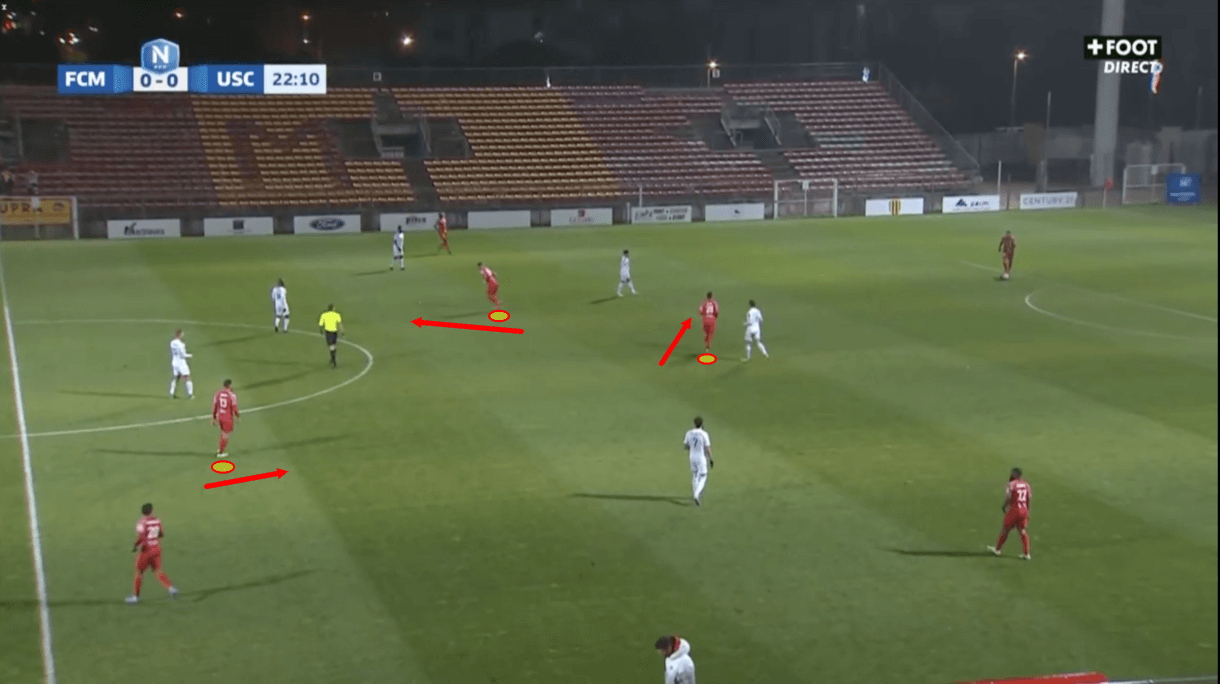
To answer that question, we first need to look at how Poirier’s side begin their possession phases and start to build their attacks. Martigues generally defend in a 4-2-3-1 shape but with the ball, it’s common to see one of their two holding midfielders advance upfield, effectively forming more of a 4-1-2-3. The advanced holding midfielder and the ‘10’ will occupy the half-spaces on either side of the centre-forward, with the wingers positioned outside them.
At the same time, as the possession phase begins for Martigues, the other holding midfielder will drop to make himself a good short passing option for the centre-backs. We see this movement from the holding midfielders in action in figure 1.
Meanwhile, the ‘10’ often drops into slightly deeper positions as his team looks to build out from the back. Dropping from his more advanced position, he can find himself unmarked in between the lines, offering a good line-splitting pass option for the centre-backs when the shorter passing options are marked out of the game.
Movement is evidently key for the midfield trio during the build-up and ball progression phases. While all three men perform distinctly different roles, all share the similar requirement of moving to find space and make themselves a good passing option, though all will represent different types of passing options and will move in different areas of the pitch; all hope to lose their marker or, alternatively, create the space necessary for a teammate to get on the ball and drive the team forward in that manner. Achieving either of those two goals will make it a job well done for the midfield, as the team looks to progress through the centre into the opposition’s half.
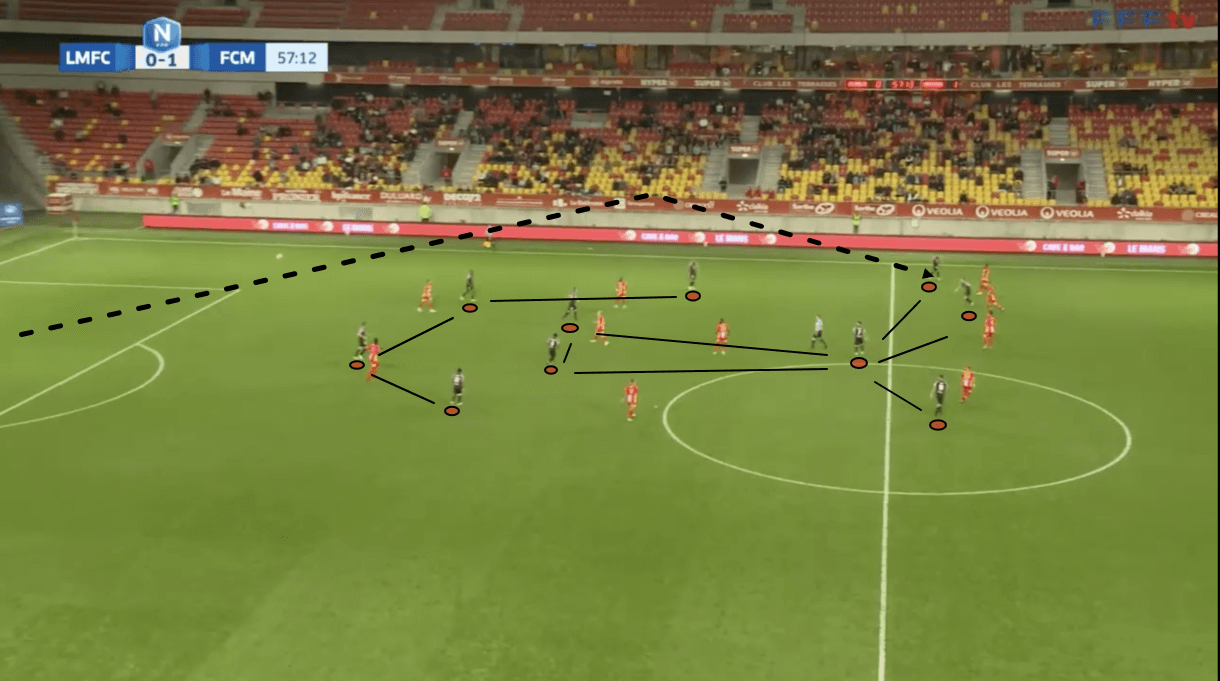
Martigues won’t always play it short from the back, they may go long, which we see an example of in figure 2, above. This occurs more often when in the lead in the second half of the game. Figure 2 displays the shape we see Martigues form when playing a long ball from the goal kick.
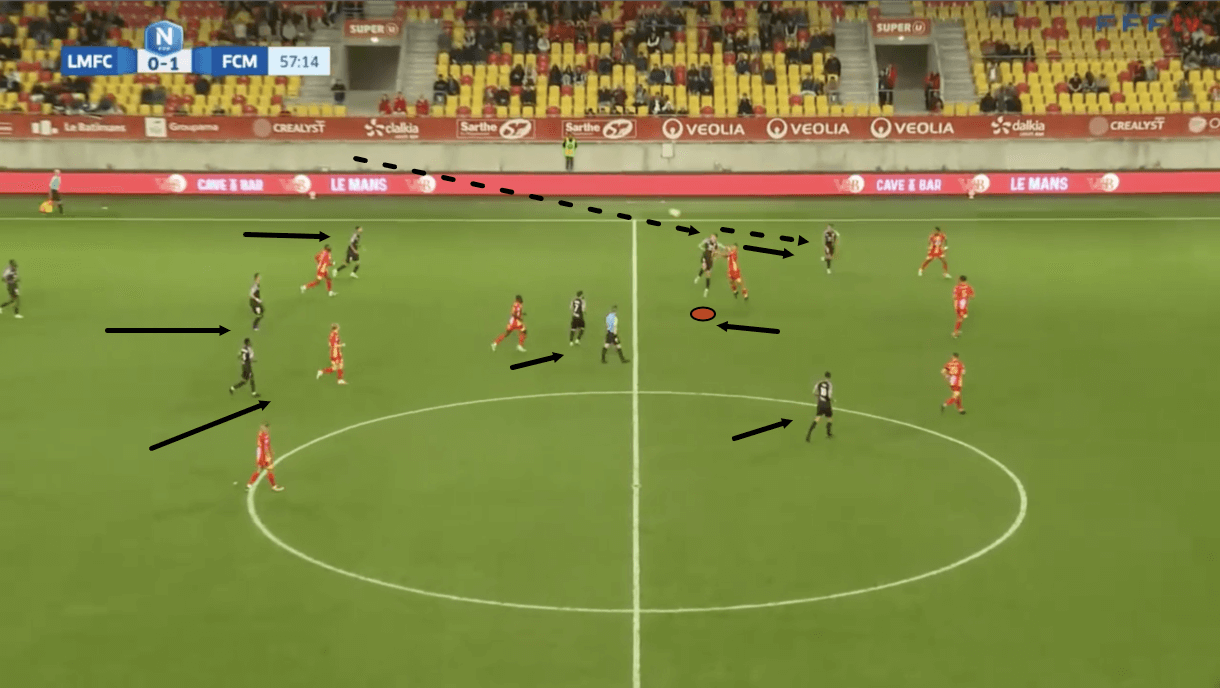
As the ball gets closer to the drop point, the centre-forward drops off slightly to meet the ball in the air, while the wingers on either side of him advance to be in a position to get onto the end of the knock-on header and attack the opposition’s backline.
Meanwhile, the ‘10’, holding midfield duo and the ball-near full-back all stand by and wait for the possibility the centre-forward knocks the ball down in front of him and sets up a second-ball duel for any of them to contest — this is the purpose of positioning the team so close together when going long, as we saw in figure 2.
However, when Martigues go long like this, we generally see them look to create an opportunity for the centre-forward to just knock the ball on for one of the wingers to chase it down.
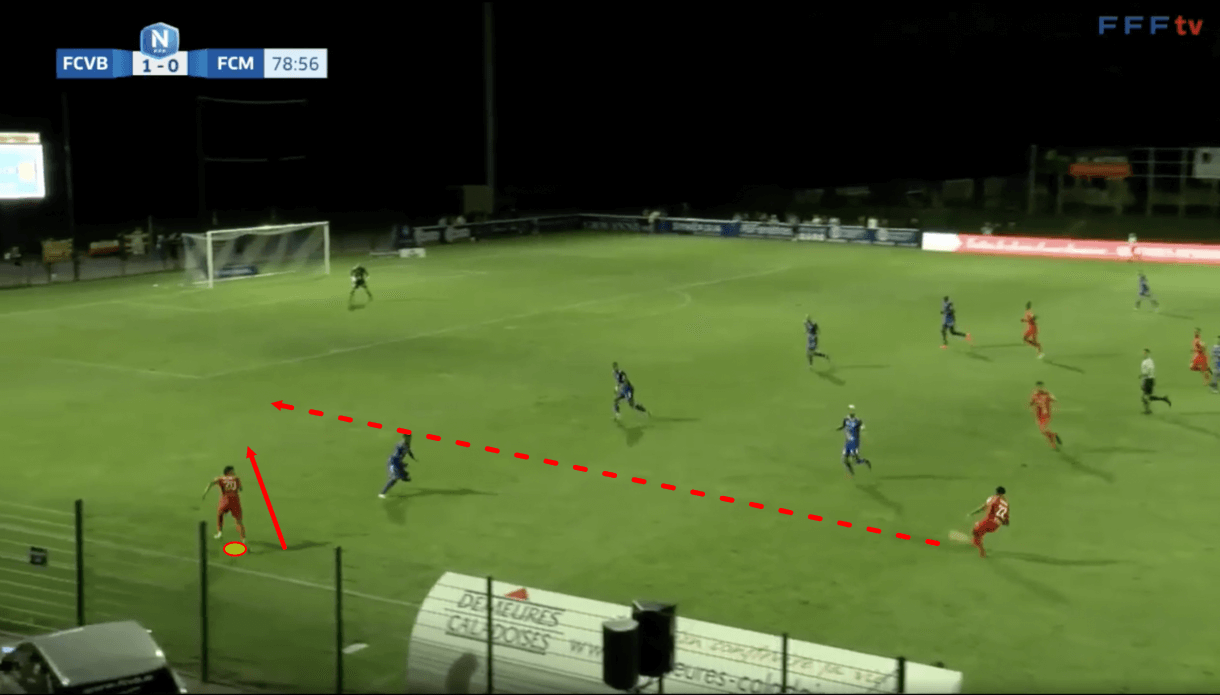
This fits the preference for Poirier’s wingers to be played in behind into the space behind the opposition’s backline. The pacey wide men love to make runs in behind and exploit this space. Indeed, Zakaria Fdaouch and Karim Tlili are capable dribblers with the ball at their feet who can take on the opposition’s full-back 1v1 too, but they tend to prefer these balls in behind more often than not within Poirier’s system.
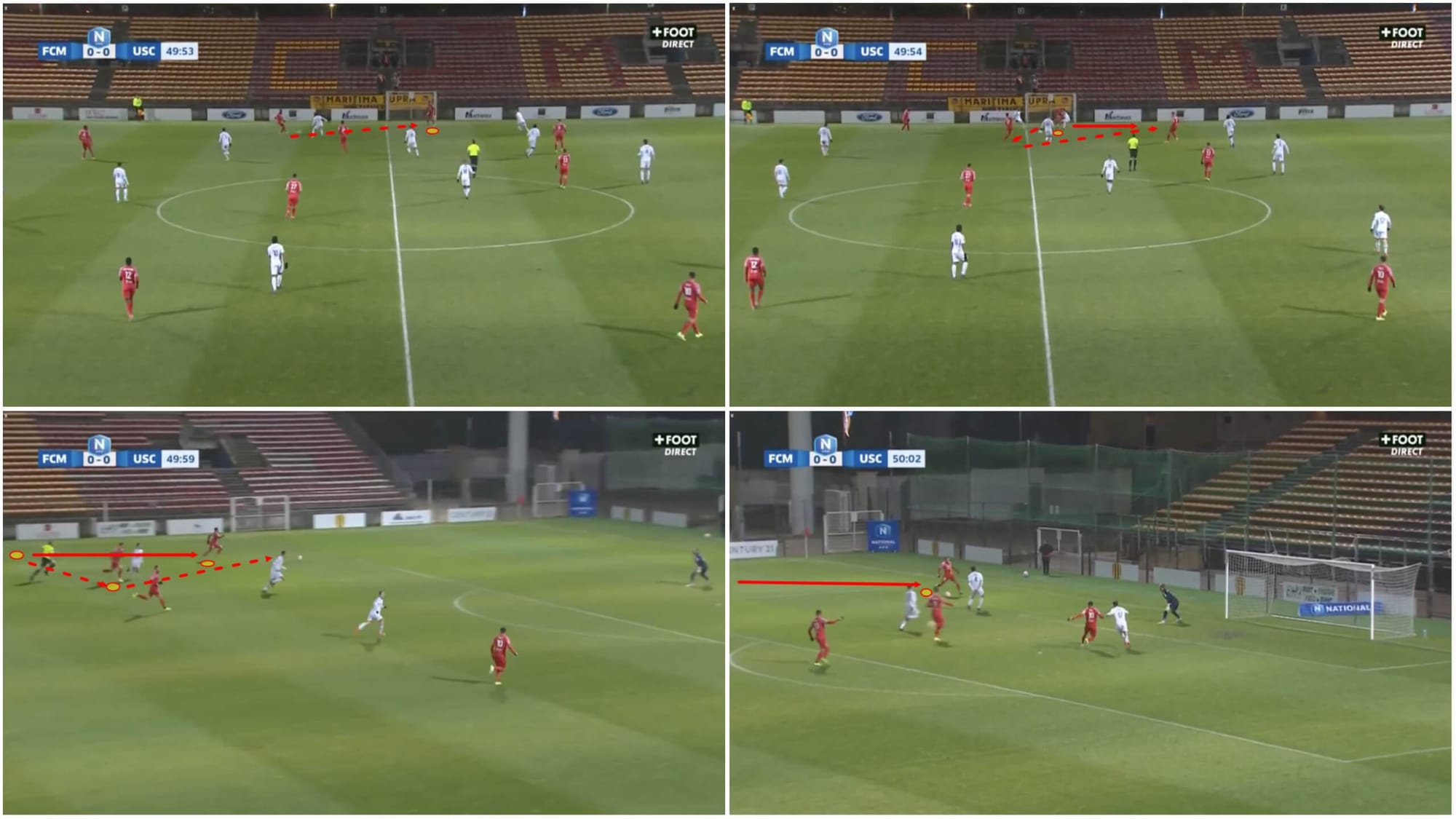
We see another example of the left-winger, Fdaouch, seeking to exploit space in behind the opposition’s backline here in figure 5. After he initially receives to feet while facing his own goal, Fdaouch attracts some pressure from the opposition full-back, drawing them in and creating space behind them that they can exploit with their subsequent run in behind, aided by this one-two with the near midfielder.
After receiving the ball again, Fdaouch performs one more one-two, this time to get around an even deeper defender and set himself up to attack the opposition’s penalty area. While the wide forward progresses into a decent crossing position in the bottom-right quadrant, he actually chooses to shoot from this seemingly awkward angle and is rewarded for his confidence as the ball sneaks past the ‘keeper at the near post. Not an ideal shooting position, but a decision that ultimately worked out for Martigues against the league leaders here.
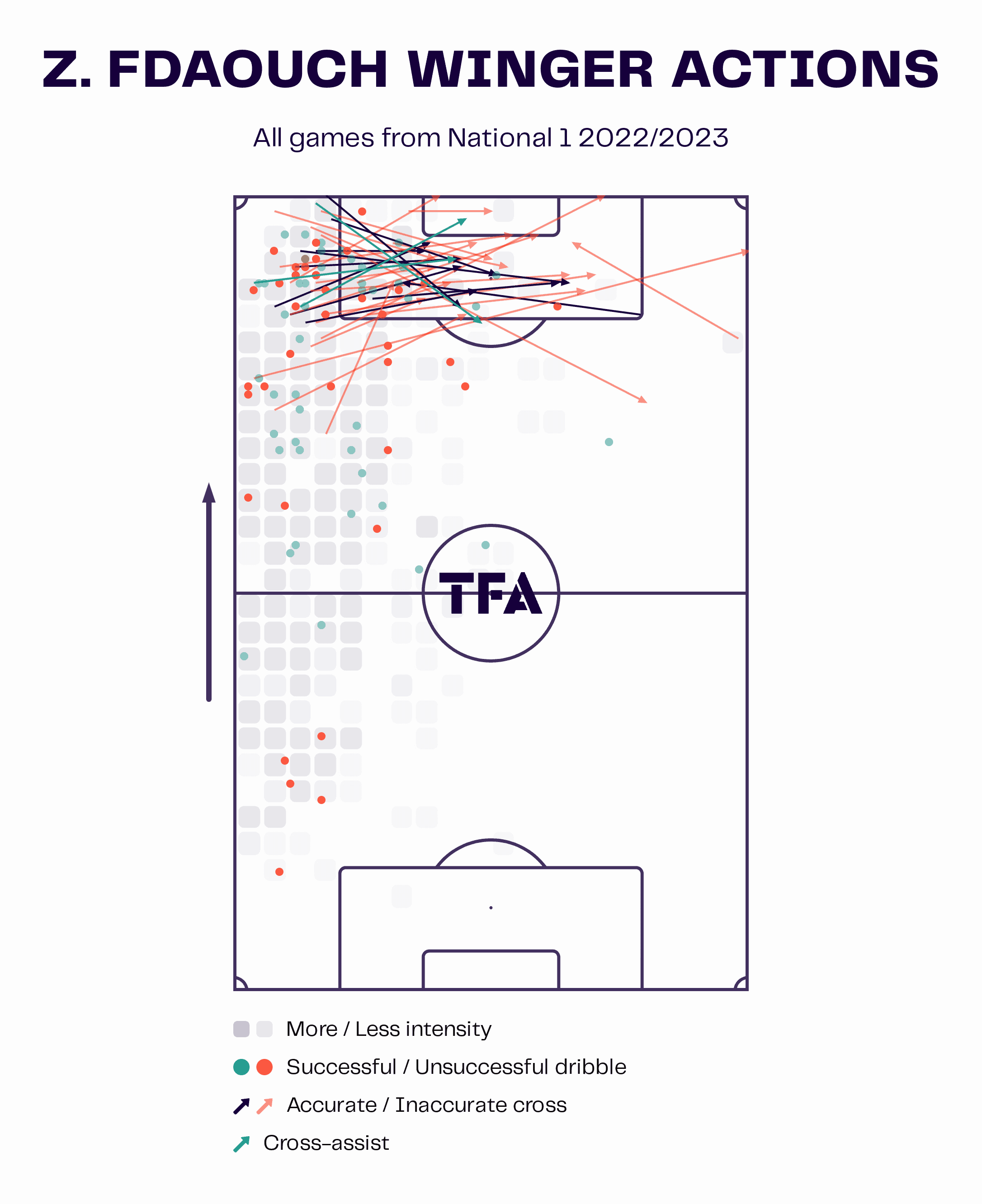
Fdaouch has been a star man on the left wing for Poirier this season. The 40-year-old coach has got the best out of the 25-year-old winger and the winger actions map in figure 6 highlights how the attacker has thrived in the 1v1 dribbling scenarios that his team has set him up with out wide and has been such a key part of the team’s chance creation via crossing and his shooting too, with Fdaouch managing four goals and five assists in the league this term at the time of writing.
The team’s preparedness and ability to catch his intelligent, well-timed runs and play him in behind has certainly played no small part in the winger’s successful campaign, as he loves to be unleashed into this space.
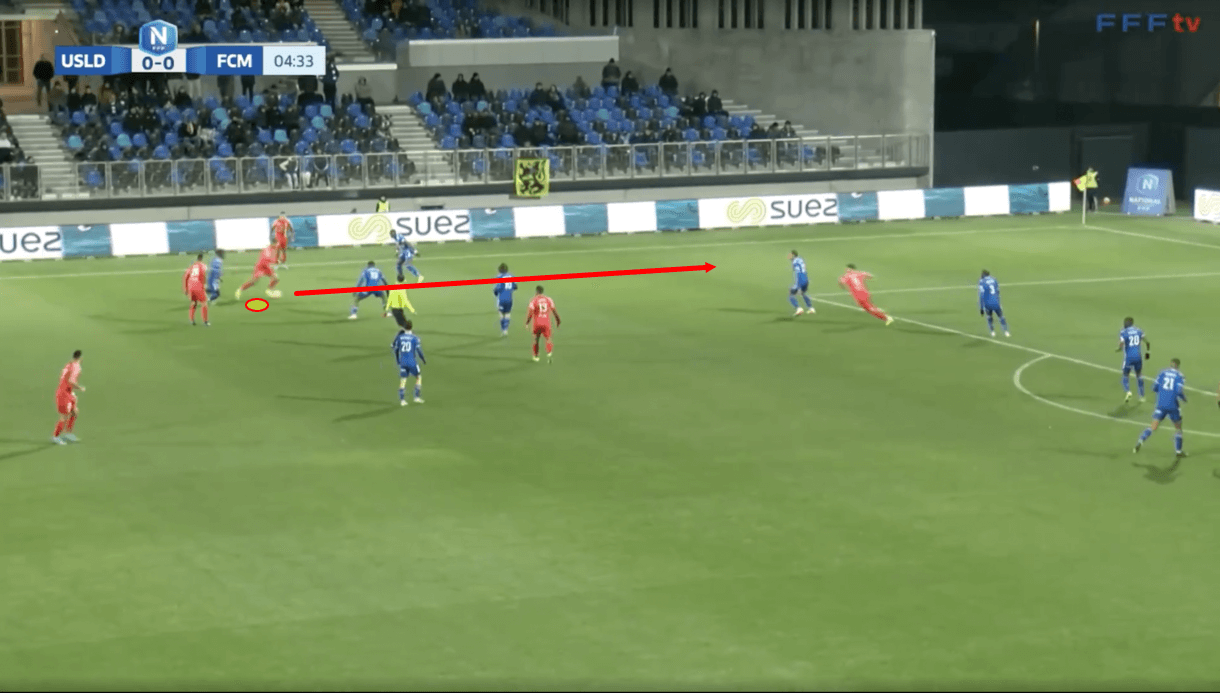
The chance creation out wide doesn’t just come from the wingers — the full-backs, especially left-back Yanis Zouaoui, also have a role to play here. In figure 7, we see Zouaoui getting on the ball and beginning to drive through some opposition defenders in front of him, targeting space behind them inside the final third.
At times, we see Zouaoui cross early from positions like this, and perhaps that’s what the opposition were expecting on this occasion. However, that wasn’t the case. The left-back got his head down and started running into the space between the defenders, leading us into figure 8, below, where we find Zouaoui in a great crossing position just inside the opposition’s penalty box.
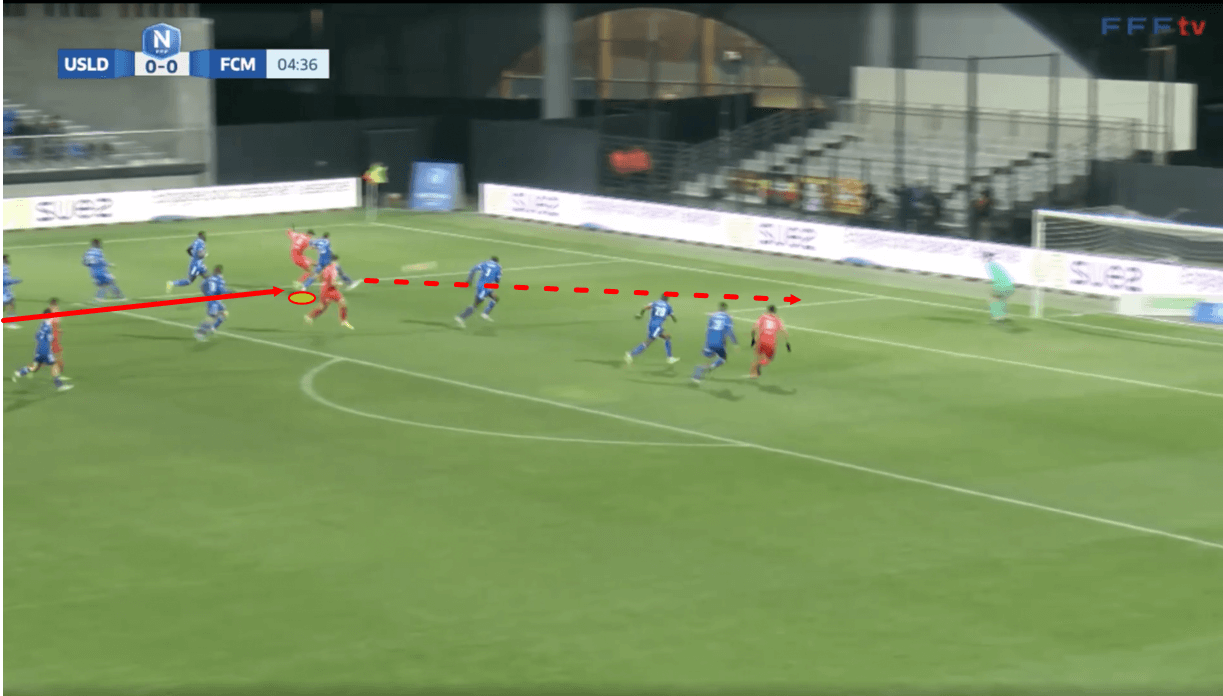
Zouaoui has been a key figure in the chance creation phase for Martigues this term, with 2.63 progressive runs per 90, 4.17 dribbles per 90 and 2.3 crosses per 90 this season — all ranking the 24-year-old highly among National 1 left-back’s in those offensive metrics in 2022/23. His link-up with Fdaouch on the left wing has helped both players to maximise their abilities, with Martigues’ left-wing proving very difficult to defend against due to the qualitative overload they often enjoy with these two running riot out wide.
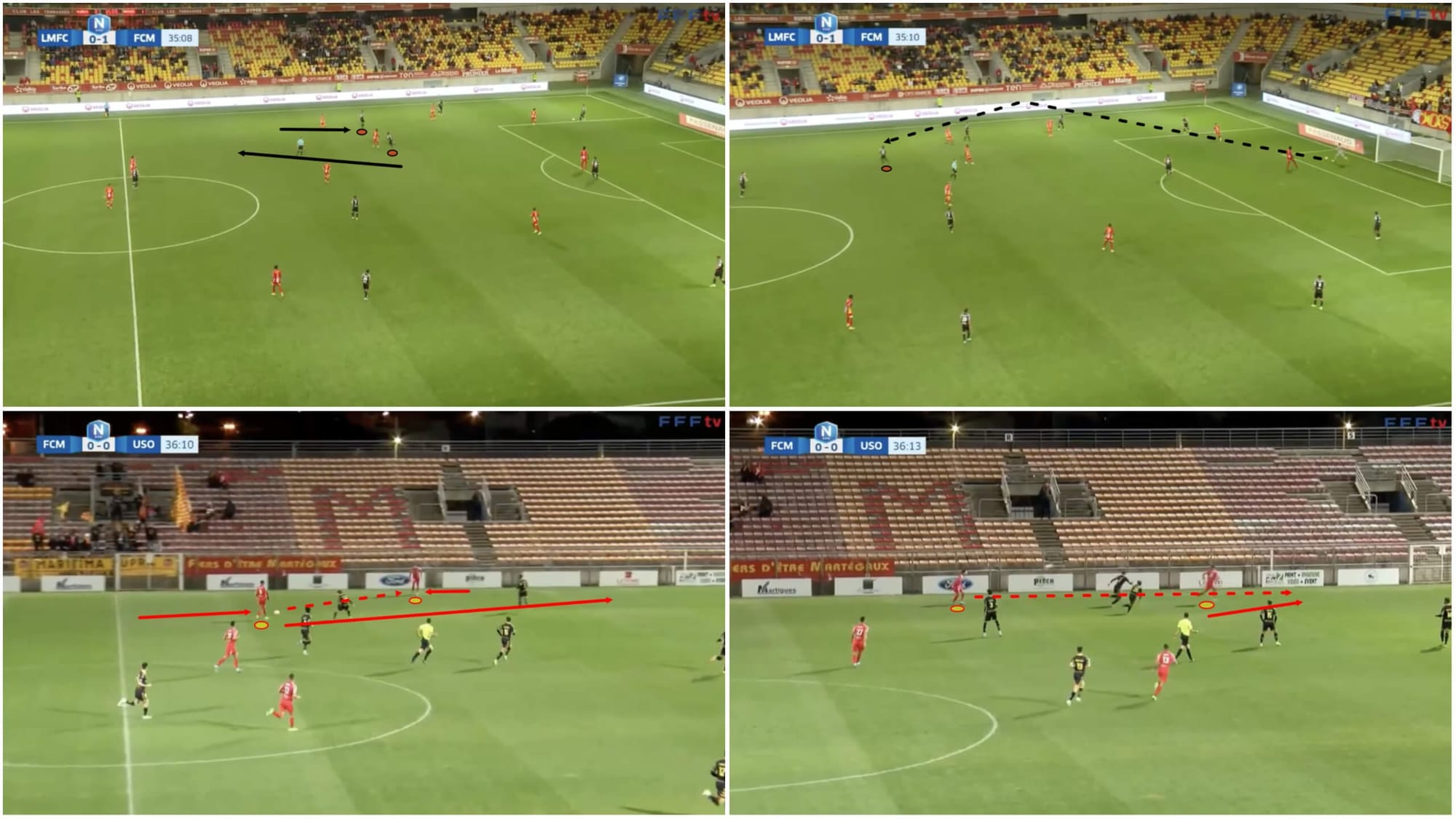
Positional flexibility is a key concept for Poirier’s side in possession. We see a couple of examples of this concept in action in figure 9. Firstly, the top half of the image shows us Martigues’ right winger dropping deep as the team begins to build out of their own third, dragging the opposition’s left-back with them in the process. This opens up space for the now-advancing holding midfielder to exploit, which he does excellently via the intelligent run we see in the top-right quadrant.
This run makes the advancing holding midfielder a great passing option that the goalkeeper takes to progress Martigues out of their own third and set them up with a good chance to break into the opposition’s half.
This was a simple rotation with one player dropping deep and another advancing high into the space he’d vacated, but the opposition struggled to deal with it as the player who had been marking the holding midfielder when he was positioned deep didn’t want to follow him all the way back, thus deserting his central position, but the opposition’s left-back was happy to follow the right-winger as he dropped off.
This created a lot of space and freedom for the advancing holding midfielder and shows one benefit of this switch in shape with one holding midfielder pushing on while the other remains deep, as discussed at the beginning of this section.
In the bottom half of figure 9, we see the left-back and left-winger linking up, with the left-winger receiving the ball to feet, dropping deep, and allowing the left-back to underlap and occupy his space further upfield, which sets up an opportunity for the winger to play the ball through for his teammate to chase.
This shows us two key aspects of this Martigues side: 1. The link-up between the left-back and left-winger and 2. The value of the positional flexibility Poirier’s side plays with. The left-winger and left-back have the license to swap positions if that’s how the attack progresses, and even the right-winger and right holding midfielder have the license to rotate as seen above if that’s where the players see the chance to exploit something in the opposition’s defensive shape.
It’s not just these players who you’ll see rotating with each other in-game for Poirier’s side, but these are two good examples of what we see a lot of from Martigues under Poirier in all phases of possession play: the liberating freedom of positional flexibility granted to distort the opposition’s defensive shape, drag the defenders about and manipulate space.
Transitions
Our next section of analysis focuses on Martigues’ transitional phases, an area of the game that all top sides have perfected, including Liverpool, Arsenal and Manchester City. We’ll spend a bit of time analysing both the transition to attack and the transition to defence for this side in our new section. We’ll start with the transition to attack, which is another key chance creation tool for Poirier.
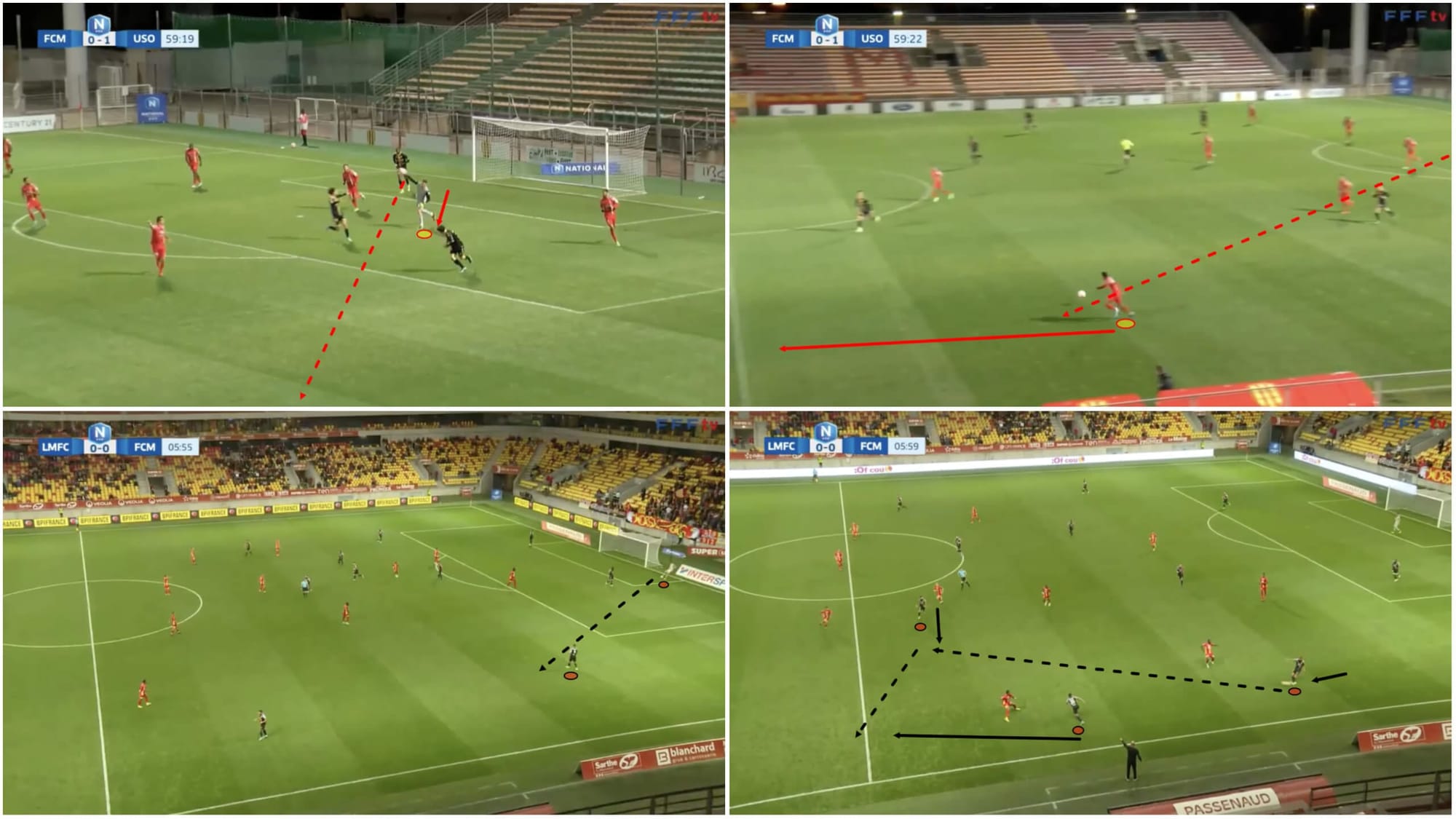
Firstly, a very notable aspect of Martigues’ tactics in transition to attack that helps them to generate opportunities against an unprepared opposition defence in transition is the goalkeeper, Jérémy Aymes, and his tendency to distribute the ball very quickly. This is especially apparent when Martigues are chasing the lead, as we see in the top half of figure 10, or when the scores are level and Martigues back themselves to break the deadlock.
It’s typical to see Aymes firing the ball out to the wingers or rolling it hastily to a free man in midfield just after collecting it to end an opposition attack so that he can kickstart a counterattack for Martigues.
In the top half example here, the ‘keeper collected the ball after an opposition cross came his way, immediately got his head up and launched the ball out to the free left-winger, who had time and space to turn and run at the opposition defence, carrying the ball into their half and attacking their backline, putting them on the backfoot just moments after they were threatening Martigues’ goal.
Quickly turning the tables on the opposition like this is a tactic Poirier loves to see his side employ, he loves this quick distribution to change defence to attack in an instant and try to catch the opposition defence sleeping. Mentally, it also makes it more difficult for the opposition to cope with the incoming counterattack when they’re immediately put under pressure just after an attack of their own.
In the bottom half of figure 10, we actually see a goal kick, so not exactly a transition, perhaps. However, just before this image, the ball went wide of the goal and we saw the ‘keeper quickly retrieve the ball and roll it into his six-yard box before picking out a quick pass to the left-back. The opposition were caught off-guard by the very quick goal kick and didn’t react quickly enough to the pass out to the left-back.
This meant the left-back had time and space to face forward, get his head up and send the ball into the centre-forward’s feet as he drifted out towards the left wing. The centre-forward was able to turn the ball into the path of his team’s overlapping left-winger from here, helping their efforts to breach the opposition’s half.
Poirier clearly stresses that his side must be prepared and alert at all times, it’s evident in their play, especially just after the end of an opposition attack. He aims for his side to be ready and take advantage of situations where the opposition might let their guard down a bit. Transition to attack is a standard example of such a situation, but it’s not the only one, as the intelligent goal kick in the second example above to generate sort of a mini transition showed us.
‘Prepared’ and ‘wily’ are two words we’d be very comfortable using to describe Poirier’s team in possession and especially with their ball progression/chance creation.
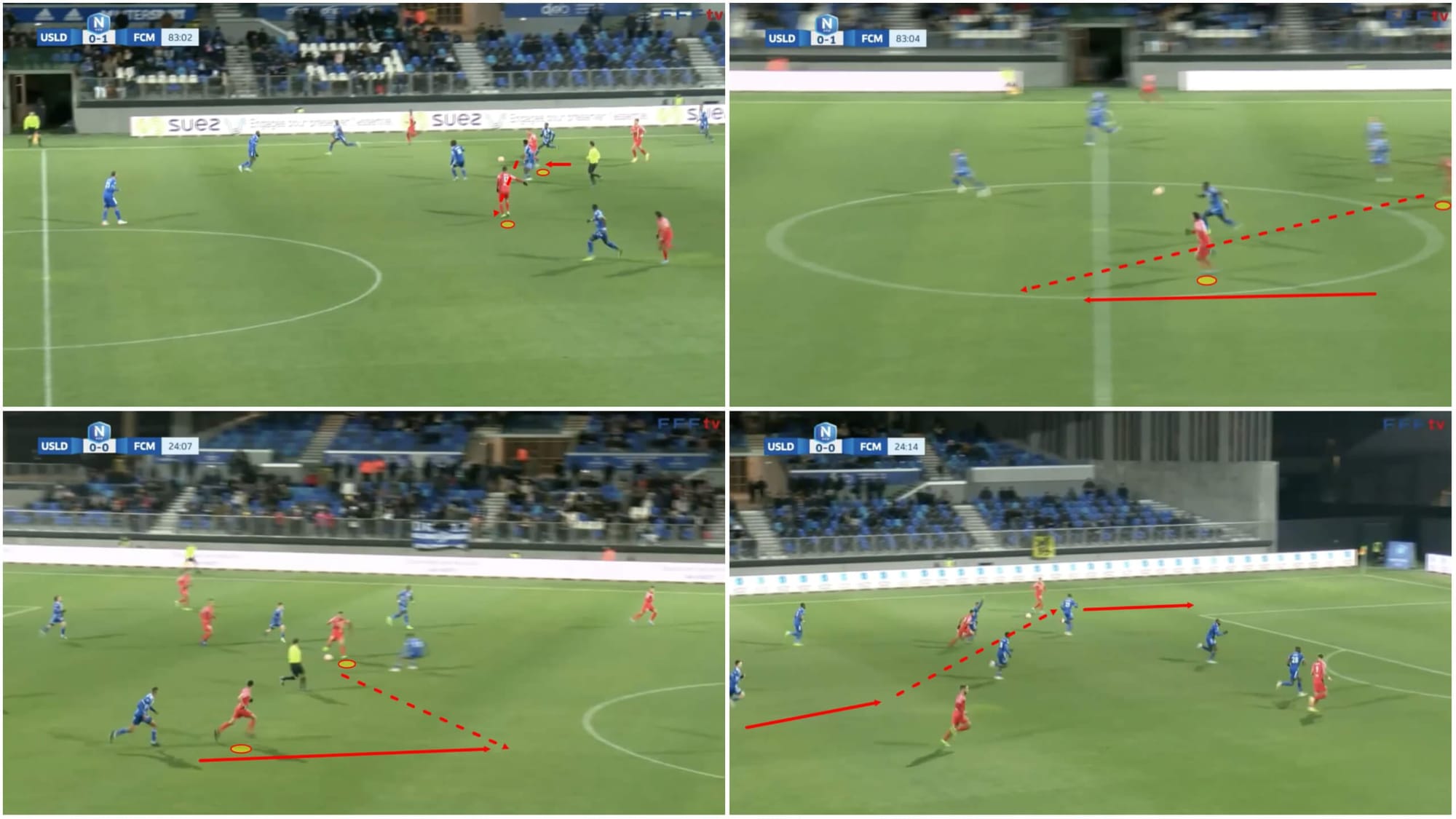
Central midfield movement is vital to Martigues’ counterattacking play as well, as figure 11 demonstrates. In the top half, the ‘10’ finds space behind the opposition’s midfield line where he can receive a line-splitting pass from his deeper midfield partner before taking the ball on the half-turn and sliding it into the path of the runner ahead of him, sending that player off to attack the opposition’s weakened backline in transition.
Amine Hemia usually plays the ‘10’ role in Poirier’s team and he’s generated a decent xA this season from passes like this one in the top half of figure 11, with the chance to make that pass coming from his prior movement to find so much space behind the opposition’s midfield line at just the right time with his team beginning their counterattack.
In the bottom half, again the midfielder’s movement into space behind the opposition’s midfield is vital as the counterattack starts, again with a deeper midfielder sliding the ball into the more advanced midfielder’s path. From here, the receiver can carry the ball forward slightly before sending it out to the left-winger, who can engage the opposition full-back in a 1v1 here.
As play moves on, we see the left-winger beat the full-back on the outside before putting a decent cross into the box for the centre-forward to connect with and just miss the target. However, this passage of play provides us with yet another solid example of Martigues’ midfield movement aiding their progression through the opposition’s defence to create a good goalscoring opportunity as Martigues enter the final third.
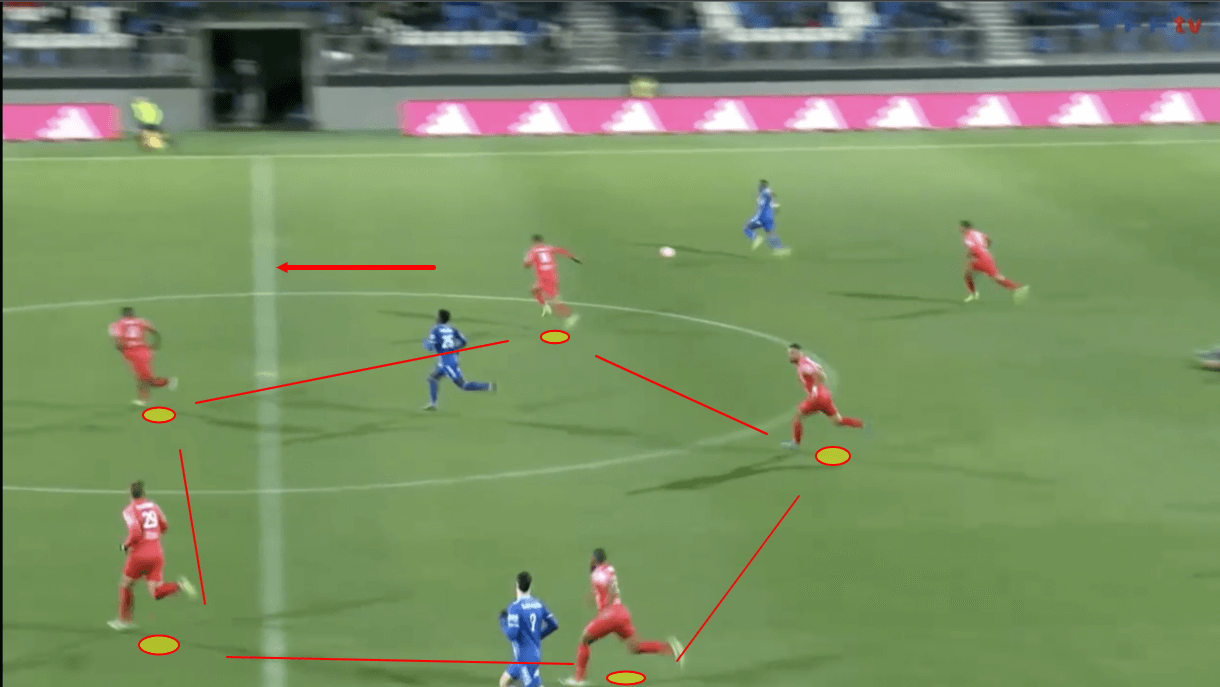
On the other side of things, when transitioning to defence, it’s common to see Martigues playing with a 2-2 rest defence comprising of the two centre-backs, the deepest midfielder and one of the two full-backs who’ll typically remain deep while the other goes forward, and will tuck inside to support the central midfielder and avoid that player becoming isolated in a valuable central area.
In figure 12, we actually see both full-backs back defending against the counterattack. Initially, here, the right-back was not back with the rest of the backline but he quickly recovered and tracked back to support his teammates as the opposition began threatening on the counter, nearing the halfway line. We see more reinforcements from midfield on the way as the ball is forced out wide by the left-back and his good defensive positioning.
These players in the rest defence shape aren’t getting too aggressive with closing down the ball carrier, they more so want to protect the valuable space and maintain a solid, compact unit in the centre that’s difficult to crack and forces the opposition to go on the outside, taking the ball a less direct route to goal. This achieves two things: firstly, it buys Martigues time for the rest of their team to track back and get into a more organised defensive shape. Secondly, it forces the opposition into less valuable areas for chance creation than the central areas they’d love to be occupying at all times.
Out of possession
For our final section of analysis in this scout report, we’re going to look at Martigues’ tactics out of possession. While they tend to build up with one player occupying the holding midfield role, as mentioned, they generally defend with a double-pivot and most frequently tend to defend with either a 4-2-3-1 or 4-4-2 shape.
We’d argue Martigues’ defending has been even more impressive than their attacking this season. They’ve conceded the fifth-fewest goals (15) in National 1 while generating the fourth-lowest xGA (14.06).
They engage in lots of defensive duels (73.1 per 90 — the fifth-most in France’s third tier) and make plenty of interceptions (43.88 per 90 — the second-most in their division), while their PPDA is relatively high at 10.57 — making it the sixth-highest in National 1 — or indicating that they don’t tend to press very aggressively, in more straightforward terms.
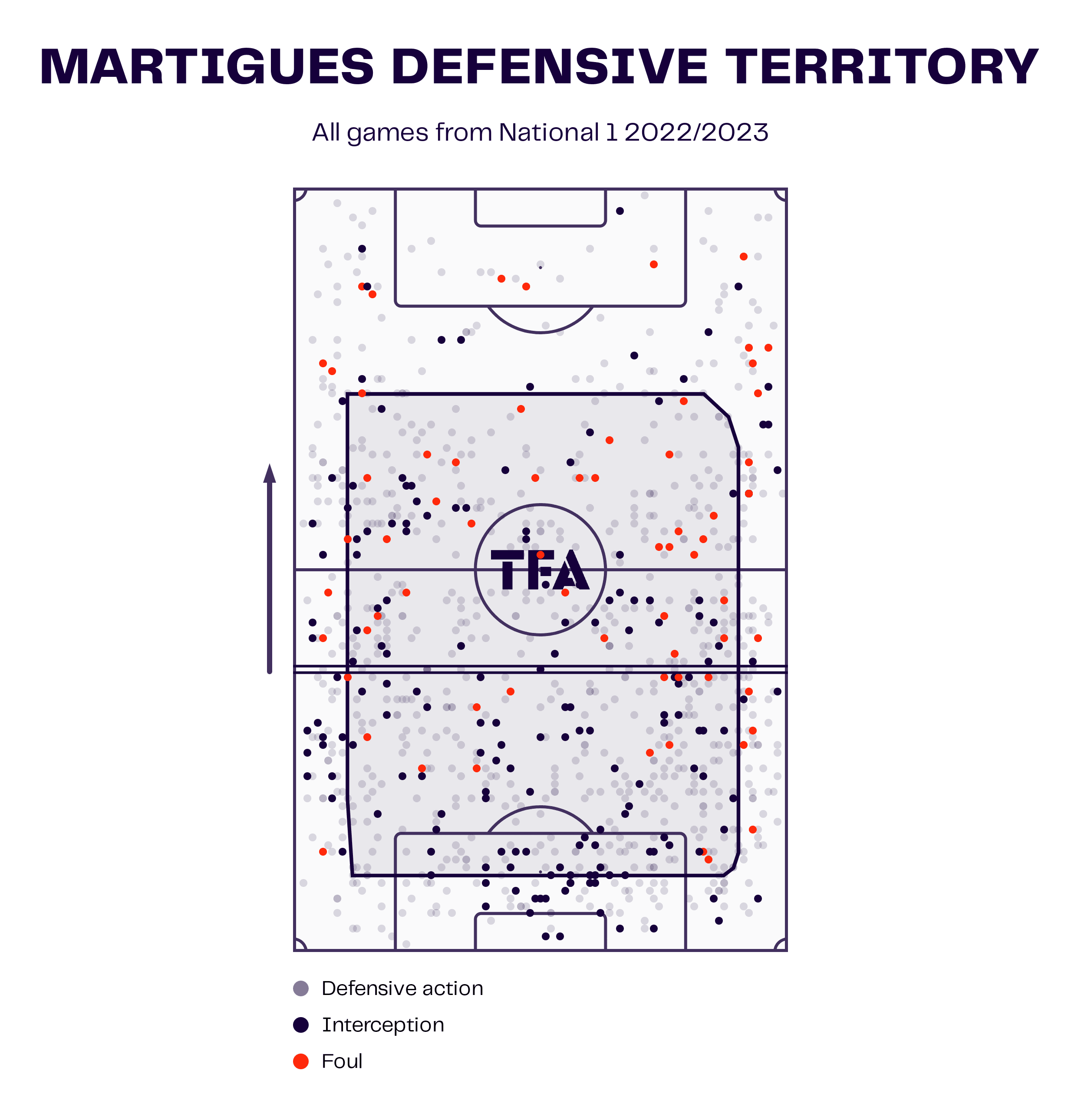
Indeed, Martigues don’t generally press very high up the pitch. They don’t usually play with a very high line and are most commonly found in the mid-block phase of play with the opposition having just passed the halfway line when their pressing intensity kicks it up a notch.
Figure 13 presents Martigues’ defensive territory map from 2022/23 and this further illustrates what we’ve said about Martigues’ average defensive line height and shows us where they most often engage in defensive duels or make interceptions, with a lot of those coming within their own third of the pitch and the vast majority coming inside their own half.
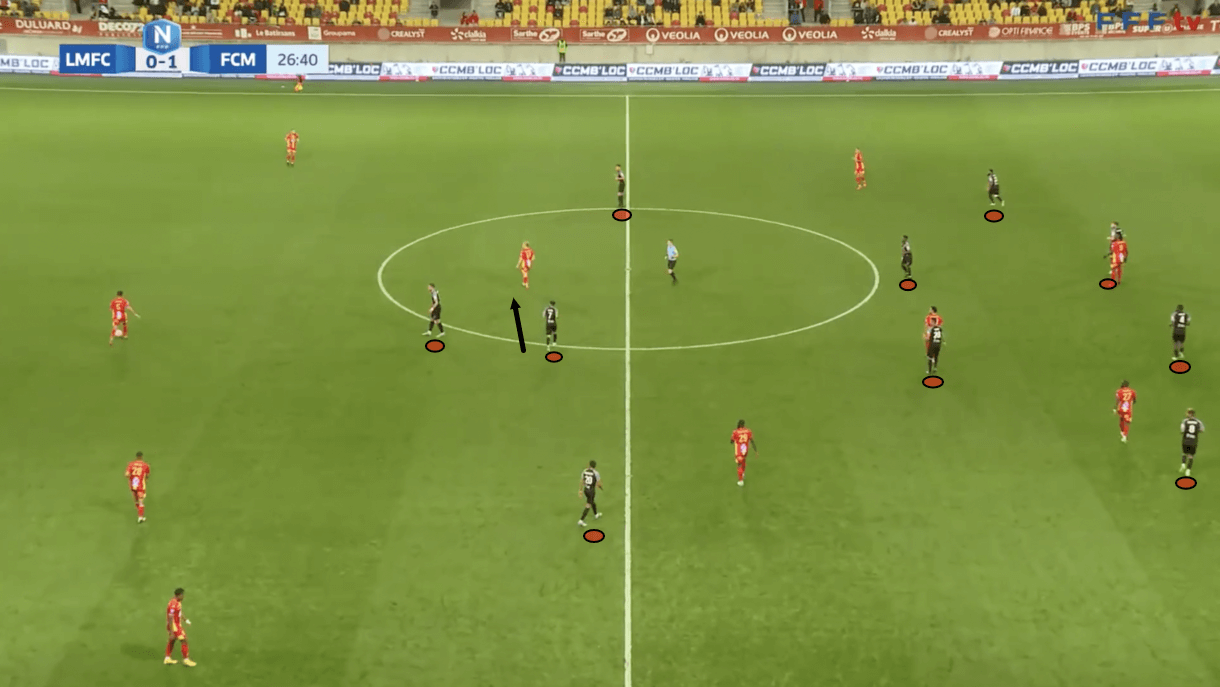
We see an example of Martigues’ 4-2-3-1 mid-block shape in figure 14; the main aim for Martigues in this phase of play is preventing the opposition from playing the ball into a valuable area and turning to face their goal. They want to keep the play outside of their 4-2-3-1 block by remaining compact and controlling the central space in their position-oriented system.
There’s especially a lot of responsibility placed on the midfielders and attackers to remain disciplined in this phase. They can’t get drawn out, leaving an easy pass open for the opposition to work their way through the defensive shape. They must ensure they remain compact, keeping space at a minimum while shadowing/marking potential receivers.
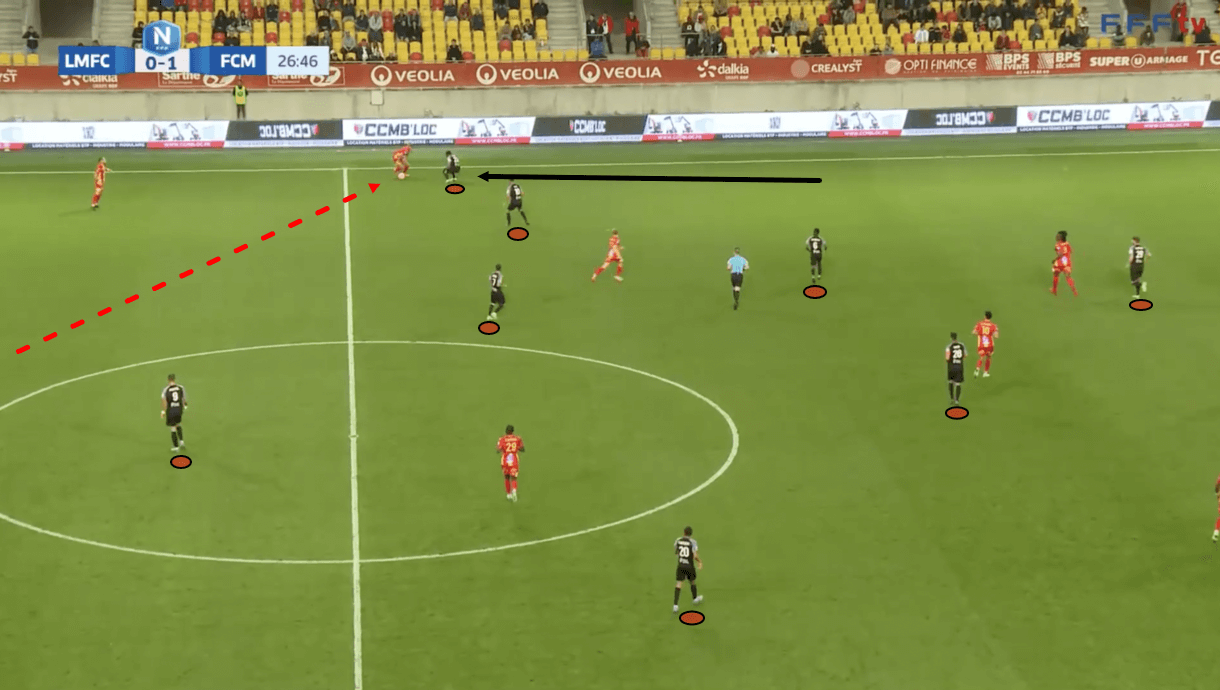
Advancing into figure 15, here we see how Martigues’ defensive block reacts to the ball being played out wide. The full-back, rather than the winger, closes down the receiver out wide. The full-back advances to cover the opposition winger who receives out at the touchline, allowing the winger to remain compact and keep the near-passing options in midfield covered while ensuring Martigues retain dominance in the central zones.
Again, Martigues’ priority in this phase is controlling the middle part of the pitch and preventing the most valuable space from being exploited, which they can do by retaining an organised, compact shape in the centre of the pitch. They’re happy enough for the opposition to have the ball outside of this block, as those areas aren’t as valuable and they don’t want to risk opening up the midfield to close down a player out wide.
It’d seem they deem sending the right-back forward as less risky here, as no passing option exists further up on the wing behind the right-back. Of course, a player could’ve shifted out wide to exploit that space behind the full-back, but at this stage, the full-back is positioned well to close down any attempted forward pass from this ball carrier. From here, the ball carrier has very few options, highlighting the benefit of Martigues’ compact, disciplined, organised 4-2-3-1 mid-block.
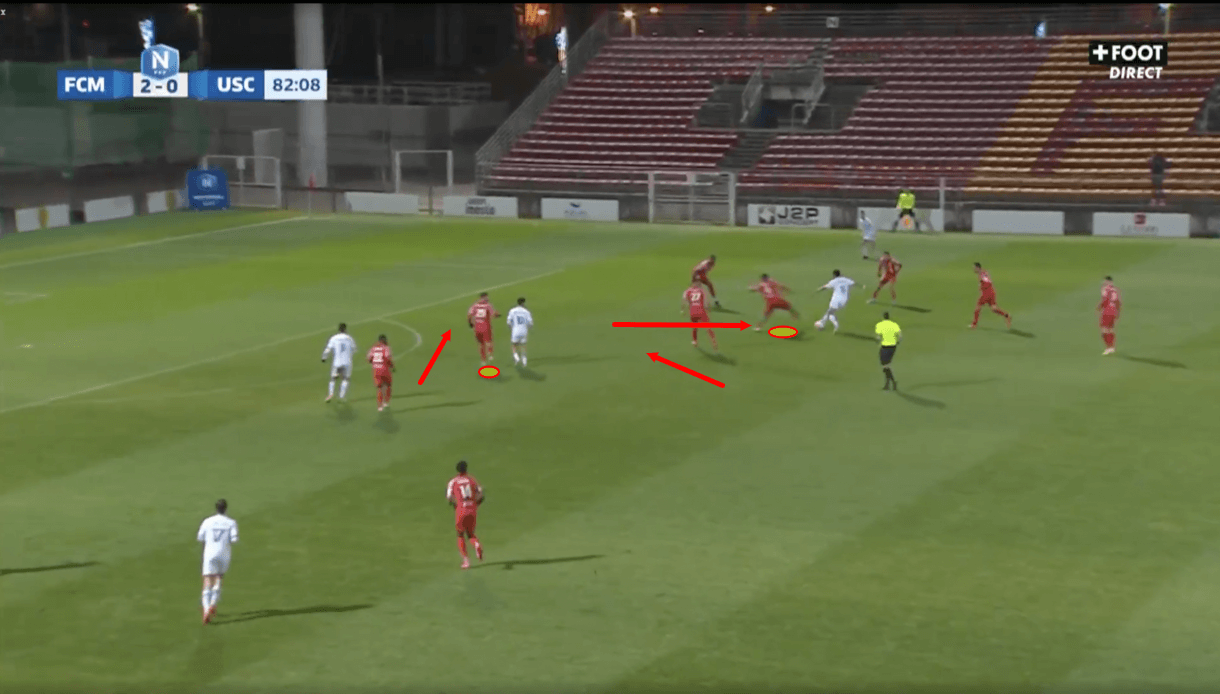
Martigues’ centre-backs aren’t the most proactive centre-backs in the world. However, it’s common to see one of them stepping out and performing the role of the aggressor while the other covers the space behind, acting more as a sweeper. Both Lucas Toussaint and Ahmed Soilihi perform the aggressor role at times, depending on where the opposition play the ball to as they enter the final third. However, Soilihi is better than Toussaint as an aggressive centre-back, though, again, both are probably better and more comfortable playing more passively.
Soilihi is better than Toussaint when defending more aggressively, though, largely due to his physical capabilities. He’s faster and more agile than Toussaint, so can deal with tricky dribblers better in 1v1s, while Toussaint finds it more difficult to deal with dribblers in 1v1s and lacks the agility to react to quick movements from the ball carrier in a 1v1. Not to mention pace — Soilihi trumps Toussaint in this area and it can help with recovering if the dribbler does come out on top.
Both players are good readers of the game with good anticipation and ability to make interceptions, especially when covering behind but also when required to step out — this isn’t a problem for either man, it’s more in 1v1s facing off with a dribbler where they might have difficulties, so this could be something for opposing teams to try and exploit.
Conclusion
To conclude this tactical analysis and scout report, we’ve been impressed by Poirier’s performance with Martigues this season and we hope our scout report has provided some in-depth insight into the young manager’s tactics with Martigues, which have been very successful so far on the rollercoaster club’s return to Championnat National 1.
If Poirier can keep the level as high as it’s been at Martigues this term heading into the second half of the campaign, we should see them right up there at the business end of the campaign, and perhaps a historic return to Ligue 2 may not be far off.





Comments